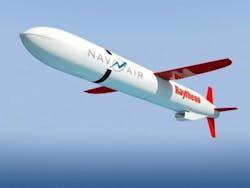Raytheon to build 111 Tomahawk land-attack missiles with GPS, inertial, and terrain-matching guidance systems
PATUXENT RIVER NAS, Md. – U.S. Navy land-attack experts are asking Raytheon Technologies Corp. to build 111 BGM-109 Tomahawk Block V missiles able to attack ground and sea targets under terms of a $171.2 million order announced Friday.
Officials of the Naval Air Systems command at Patuxent River Naval Air Station, Md., are asking the Raytheon Missiles & Defense segment in Tucson, Ariz., to build 111 full-rate production Block V Tactical Tomahawk all-up round vertical launch system missiles -- 50 of which are for the U.S. Army, 48 for the U.S. Navy, and 13 for the U.S. Marine Corps.
Tomahawk is a long-range, all-weather, jet-powered, surface-attack subsonic cruise missile used primarily by the U.S. Navy and the United Kingdom Royal Navy in ship- and submarine-based land-attack operations. The missile also launches from land sites.
For navigation and guidance, the missile uses a combination of inertial, GPS, and terrain-matching that uses an electro-optical sensor and radar altimeter to the terrain over which the missile is passing to an internal terrain database.
The Tomahawk Block V is the latest version, and is an upgraded Tomahawk Block IV, which has a data link that enables the missile to switch targets while in flight. It can loiter for hours and change course instantly on command.
The Tomahawk Block V is a recertified and modernized missile with upgraded navigation and communications. The Block Va can strike moving targets at sea, while the Block Vb has a multi-effects warhead that can hit diverse land targets. Tomahawk's most recent use was in 2018 when U.S. Navy surface warships and submarines launched 66 Tomahawk missiles at Syrian chemical weapon facilities.
Tomahawk Block V was introduced in 2021 with improvements to navigation and in-flight targeting. Block Va, the Maritime Strike Tomahawk (MST), enables the missile to engage a moving target at sea, and Block Vb outfitted with the Joint Multiple Effects Warhead System (JMEWS) warhead for hard-target penetration.
Tomahawk Block V have longer range and dynamic targeting than its predecessors, and has unique flight, launch, and information-processing capabilities. Raytheon can integrate a new sensor suite into the Tactical Tomahawk quickly. The company provides seeker, processor, software, and a new inertial measuring unit for terminal maneuvers, as well as redesigned power budget and system cooling.
On this contract Raytheon will do the work in Ogden and Spanish Fork, Utah; Camden, Ark.; Huntsville and Anniston, Ala.; Clearwater, Fla.; Glenrothes, Scotland; Joplin, Mo.; El Segundo and Moorpark, Calif.; Middletown, Conn.; Midland, Ontario; Vergennes, Vt.; Minneapolis; Westminster, Colo; Chandler, Ariz.; and other U.S. locations, and should be finished by November 2025.
For more information contact Raytheon Missiles & Defense online at www.raytheonmissilesanddefense.com, or Naval Air Systems Command at www.navair.navy.mil.
About the Author
John Keller
Editor-in-Chief
John Keller is the Editor-in-Chief, Military & Aerospace Electronics Magazine--provides extensive coverage and analysis of enabling electronics and optoelectronic technologies in military, space and commercial aviation applications. John has been a member of the Military & Aerospace Electronics staff since 1989 and chief editor since 1995.
